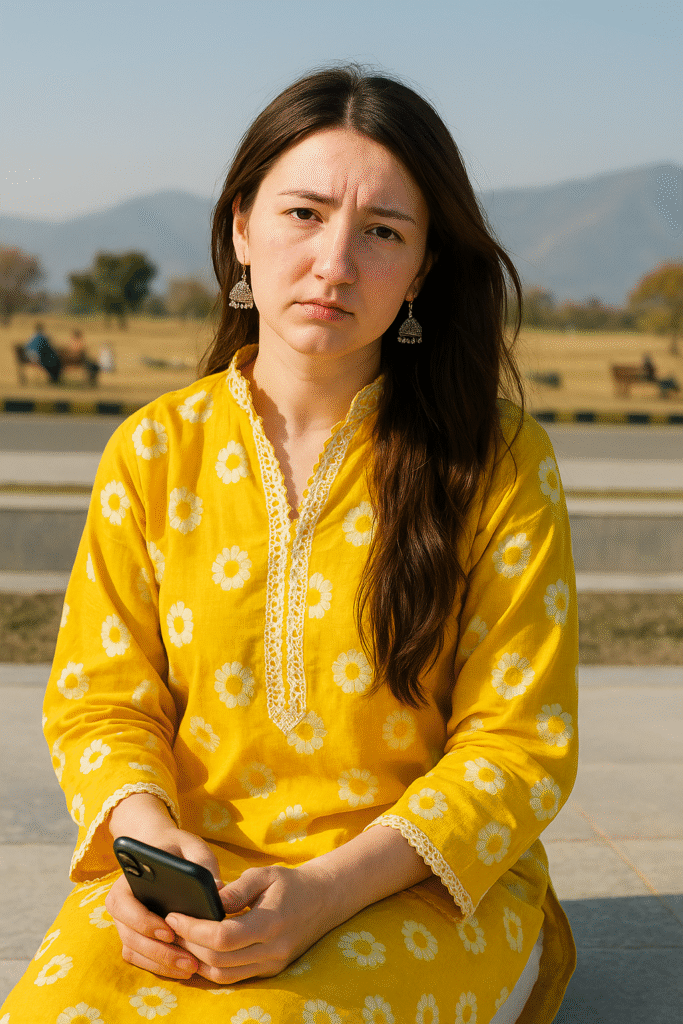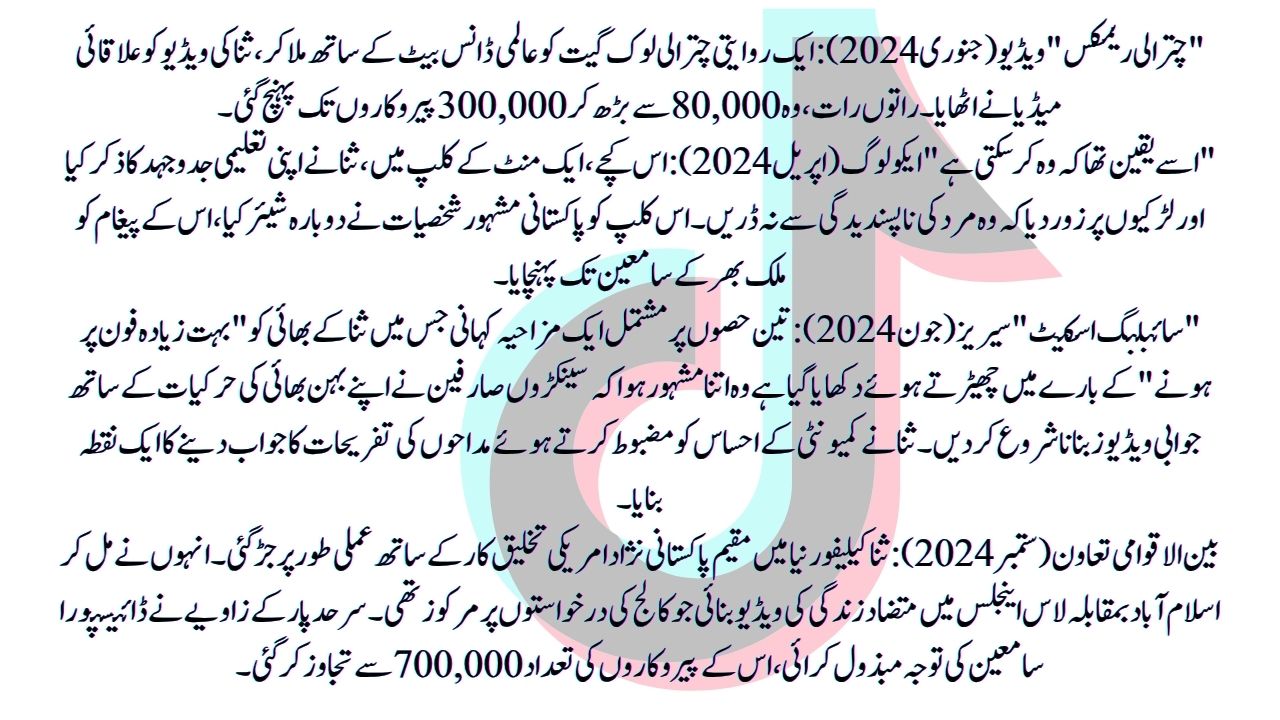By weaving together cultural heritage, personal conviction, and digital savvy, Sana Yousaf emerged as one of Pakistan’s brightest TikTok stars. What started as simple clips celebrating Chitrali customs evolved into a platform for women’s empowerment, motivational messaging, and humor—transforming a 17-year-old girl from Islamabad into a voice for Gen Z. This is the unique story of how Sana turned a mobile phone into a megaphone and captured the hearts of hundreds of thousands.
Early Beginnings: A Curious Mind Meets a Global Platform
Born on April 29, 2008 in Upper Chitral’s Chunj region, Sana Yousaf spent her earliest years surrounded by mountain air, traditional music, and close-knit community life. When her family relocated to Islamabad, Sana discovered the internet—not as a distraction, but as a window onto possibilities. A studious teenager balancing schoolwork with family responsibilities, she was curious about technology’s ability to connect far-flung voices.
By the time TikTok gained mainstream traction in Pakistan (circa 2020), Sana had already watched countless short videos on YouTube and Instagram, noting how creators could blend everyday moments with catchy audio clips. At age 14, she downloaded TikTok on a family-handed smartphone, primarily out of curiosity. Her first videos were experimental—recorded at her home in Sector G-13 with a simple backdrop, often featuring her speaking in her native Khowar dialect or lip-syncing to popular trends.
Finding a Niche: Chitrali Culture Meets Modern Trends
Thousands of aspiring creators were uploading dance clips and comedic skits. How would a girl from a northern valley stand out? Sana realized early that authenticity would be her strongest asset. Rather than attempting to mimic popular influencers from urban centers, she chose to celebrate the legacy of Chitral.
Her “cultural pride” series began with videos showcasing traditional Chitrali dress (the embroidered Wuchuq), short explanations of Chitrali festivals, and glimpses of folk melodies. These clips resonated not only with viewers from Chitral but also with younger Pakistanis curious about regional heritage. The videos were sprinkled with modern editing—fast cuts, trending song snippets, and playful captions—so they never felt like dry history lessons. Instead, they felt like an energetic invitation to experience a culture many had never encountered.

A turning point came when one of her videos—featuring Sana elegantly wrapping a Chitrali shawl while humming a local tune—coincided with a viral TikTok dance trend. She layered the traditional melody over a globally trending beat, creating a seamless remix that captured two audiences at once: those seeking fresh cultural content, and those looking for the next catchy audio mashup. The video exploded to over 150,000 views within a day.
Blending Humor and Heart: The Voice of Gen Z
Beyond cultural clips, Sana understood that laughter was universal. She started weaving humorous skits about everyday teenage life: struggling to study for exams, sibling banter at home, and the challenge of convincing a conservative older relative to allow her to pursue online aspirations. These short sketches were relatable, shot in her bedroom or on the staircase outside her house, and often under fifteen seconds long—perfect bite-sized entertainment that TikTok’s algorithm favored.
What truly set her apart was how she layered these skits with genuine emotion. In one clip, she pretended to “argue” with her own reflection about whether to study medicine or become an influencer—a nod to her real-life dilemma. By showcasing her academic ambitions alongside her creative side, she humanized the influencer persona. Fans began commenting, “I’m in the same boat,” and “Your life is like mine!” This sense of shared experience fueled a deeper connection between Sana and her followers.
Advocating for Women’s Rights and Education
Sana did not confine herself to lighthearted content. As her follower count passed 100,000, she recognized the platform’s potential for change. Guided by values instilled by her father—an established social activist in Islamabad—she began posting short, candid monologues advocating for girls’ education, women’s safety, and mental health awareness.
One notable video showed her sitting at a desk, addressing the camera directly: “In Chitral, my cousins have to wake up before dawn just to fetch water. Their sisters often drop out of school. But what if every girl could dream beyond that bucket of water?” She then contrasted that image with footage of herself studying medical textbooks, smiling at the camera as she flipped a page. That contrast—between a remote valley’s hardships and her own path—struck a nerve. Within hours, the clip garnered thousands of comments praising her honesty and calling on parents to invest in their daughters’ dreams.
Over the next several months, Sana partnered with local NGOs online to amplify campaigns promoting literacy among rural girls. She occasionally included links in her Instagram bio, encouraging small donations to purchase books for village schools. Although her main stage was TikTok, she integrated multi-platform calls to action, weaving together advocacy and entertainment with purpose.
Navigating the TikTok Ecosystem: Trends, Collaboration, and Consistency
Like any successful TikToker, Sana paid close attention to the platform’s shifting currents. She watched trending audio sounds and participated in challenges, but always gave them her unique twist. A viral “duet” trend—originally a comedic exchange between two creators—became her opportunity to spotlight Chitrali proverbs. She recorded herself voicing the regional saying “مرچ کم، مزہ زیادہ” (“less spice, more flavor”) while a friend (off-camera) matched her lip-sync, injecting humor and cultural flavor into a mainstream format.

Collaboration also fueled her growth. In late 2023, Sana teamed up with a fellow female TikToker from Lahore to launch a duet series discussing teenage pressures—school, friendships, and familial expectations. These cross-city collaborations introduced her to a broader Punjabi audience while reminding existing fans that Pakistani youth were more alike than their geographic labels suggested.
Equally important was consistency. Sana committed to uploading three to five videos per week, each carefully planned. She balanced short, funny skits with longer (up to 60 seconds) cultural or motivational pieces, ensuring a varied feed that kept viewers engaged. Fans appreciated her reliable schedule—many commented they looked forward to “Sana Saturdays,” where she posted a mini-tour of her family home or offered study tips before exams.
Milestones and Breakthrough Moments
A series of key videos propelled Sana from rising star to household name:
- The “Chitrali Remix” Video (January 2024): By blending a traditional Chitrali folk song with a trending global dance beat, Sana’s video was picked up by regional media outlets. Overnight, she jumped from 80,000 to over 300,000 followers.
- “She Believed She Could” Monologue (April 2024): In this raw, one-minute clip, Sana recounted her own academic struggles and urged girls not to fear male disapproval. The clip was reshared by Pakistani celebrities, amplifying her message to a nationwide audience.
- “Sibling Skit” Series (June 2024): A three-part comedic saga showcasing Sana’s brother teasing her about “being on the phone too much” became so popular that hundreds of users started creating response videos with their own sibling dynamics. Sana made it a point to respond to fan recreations, cementing a sense of community.
- International Collaboration (September 2024): Sana connected virtually with a Pakistani-American creator based in California. They co-created a video contrasting life in Islamabad versus Los Angeles—focusing on college applications. The cross-border angle attracted attention from diaspora audiences, propelling her follower count past 700,000.

Each of these milestones was more than just a viral moment—they marked her ability to pivot between cultural resonance, personal storytelling, and global trends.
Engaging the Community: Building a Loyal Fanbase
Unlike many influencers who maintain an aloof distance, Sana made genuine efforts to interact with her followers. She hosted weekly Q&A livestreams on Instagram, where fans asked everything from “What’s your favorite study hack?” to “How do I stay confident when people criticize me online?” Sana’s approach was transparent: she admitted mistakes, like mixing up TikTok sounds or failing to edit captions correctly, and laughed about them. That vulnerability endeared her to fans who felt they “knew” Sana as a friend rather than just a social media persona.
She also leveraged the comment section on TikTok, responding to over 200 comments each weekend. Some influencers delegate comment replies to assistants—Sana typed her own replies, often adding personalized emojis or “thank you” notes. Consequently, fans felt seen. Many credited her for turning a one-sided broadcast into a genuine conversation.
Balancing School, Family, and Fame
Maintaining a thriving TikTok channel while studying pre-medical science was no easy feat. Sana’s weekdays were a careful juggle: early morning classes, afternoons dedicated to recording content (often in her family’s living room), and late evenings spent editing videos or replying to messages. While they set boundaries—no filming during final exams—they also allowed Sana creative freedom, understanding that her content had positive social impact.
Her father, Yousuf Hassan, occasionally appeared in her videos, playing the role of the doting, slightly strict parent. Their on-camera chemistry showed a loving but real parent-child dynamic; viewers appreciated seeing an engaged father who supported his daughter’s ambitions. Her mother, often behind the camera adjusting lighting or managing props, remained unnamed—and that element of mystery further intrigued fans. Many speculated online about the “woman behind Sana’s videos,” fueling curiosity and engagement.
Challenges and Online Backlash
Rising too quickly on social media can provoke backlash. Soon after hitting one million followers, Sana faced online trolls questioning her motives—accusing her of “westernized” thinking or “neglecting Chitrali values.” Some conservative critics complained she was “too bold” when discussing gender issues. Instead of shying away, Sana addressed these criticisms head-on. In a heartfelt 45-second video, she said, “I love my culture. I love my home. But silence is not a virtue when people need to hear their worth. This platform is bigger than me—it’s for our girls, our voices, our future.” That response was shared over ten thousand times, converting many skeptics into supporters.
Even with positive advocacy, the risk of cyberbullying loomed. Sana occasionally navigated hurtful comments or crude messages in her DMs. She opened up about online harassment during a livestream, encouraging viewers who faced similar abuse to seek help and report harassers. By turning her own struggles into educational moments, she reinforced her role as both entertainer and mentor.
Crossing Borders: International Recognition
By mid-2024, Sana’s influence extended well beyond Pakistan. South Asian diaspora viewers in the UK, Canada, and the Middle East started sharing her content. Several expatriate parents created WhatsApp groups solely to discuss her motivational speeches and fusion-culture videos. Her “Study With Me” live sessions attracted students from Dubai, sharing study tips and offering moral support in real time.
Brands took notice. A couple of Pakistani clothing labels approached her to model modest, youth-friendly outfits. Although she accepted only a few collaborations—carefully vetting products to align with her values—her partnership with a local educational app became particularly noteworthy. In a short series of promotional clips, Sana encouraged young students to try free sample lessons. The app’s downloads reportedly spiked by 40% within a week of her endorsement.
A Legacy Etched in Pixels
By early 2025, Sana Yousaf was firmly established as one of Pakistan’s leading Gen Z voices. She had scored interviews on national morning shows, penned guest columns for youth-focused magazines, and spoken at virtual webinars about digital literacy. Through it all, her follower tally continued to climb—hovering around 900,000 on TikTok and half a million on Instagram.
Yet amid growing fame, Sana remained focused on her mission: to uplift young Pakistanis—especially girls—by merging culture, humor, and advocacy. I’m here to remind people that even in remote valleys, dreams can grow.” Those words became her mantra, repeated in interviews and reflected in every video she uploaded.
Conclusion: From Local Girl to National Icon
Sana Yousaf’s rise on TikTok was never an accident of luck or mere mimicry of viral formulas. It was the product of intentional authenticity: a young woman tapping into her unique heritage, amplifying her convictions, and respecting the platform’s fast-paced nature. By balancing cultural pride with universal themes—education, empowerment, and humor—she built a bridge between Chitral’s winding mountain paths and the scrolling screens of millions.

